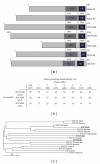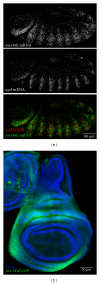Drosophila SOCS Proteins
- PMID: 22203896
- PMCID: PMC3238392
- DOI: 10.1155/2011/894510
Drosophila SOCS Proteins
Abstract
The importance of signal transduction cascades such as the EGFR and JAK/STAT pathways for development and homeostasis is highlighted by the high levels of molecular conservation maintained between organisms as evolutionary diverged as fruit flies and humans. This conservation is also mirrored in many of the regulatory mechanisms that control the extent and duration of signalling in vivo. One group of proteins that represent important physiological regulators of both EGFR and JAK/STAT signalling is the members of the SOCS family. Only 3 SOCS-like proteins are encoded by the Drosophila genome, and despite this low complexity, Drosophila SOCS proteins share many similarities to their human homologues. SOCS36E is both a target gene and negative regulator of JAK/STAT signalling while SOCS44A and SOCS36E represent positive and negative regulators of EGFR signalling. Here we review our current understanding of Drosophila SOCS proteins, their roles in vivo, and future approaches to elucidating their functions.
Figures



Similar articles
-
Two Drosophila suppressors of cytokine signaling (SOCS) differentially regulate JAK and EGFR pathway activities.BMC Cell Biol. 2004 Oct 15;5(1):38. doi: 10.1186/1471-2121-5-38. BMC Cell Biol. 2004. PMID: 15488148 Free PMC article.
-
Socs36E limits STAT signaling via Cullin2 and a SOCS-box independent mechanism in the Drosophila egg chamber.Mech Dev. 2015 Nov;138 Pt 3:313-27. doi: 10.1016/j.mod.2015.08.003. Epub 2015 Aug 13. Mech Dev. 2015. PMID: 26277564
-
SOCS36E, a novel Drosophila SOCS protein, suppresses JAK/STAT and EGF-R signalling in the imaginal wing disc.Oncogene. 2002 Jul 18;21(31):4812-21. doi: 10.1038/sj.onc.1205618. Oncogene. 2002. PMID: 12101419
-
Suppressors of cytokine signaling proteins as modulators of development and innate immunity of insects.Dev Comp Immunol. 2020 Mar;104:103561. doi: 10.1016/j.dci.2019.103561. Epub 2019 Nov 28. Dev Comp Immunol. 2020. PMID: 31785267 Review.
-
JAK/STAT pathway in Drosophila immunity.Scand J Immunol. 2014 Jun;79(6):377-85. doi: 10.1111/sji.12170. Scand J Immunol. 2014. PMID: 24673174 Review.
Cited by
-
The Drosophila JAK-STAT pathway.JAKSTAT. 2013 Jul 1;2(3):e25353. doi: 10.4161/jkst.25353. Epub 2013 Aug 1. JAKSTAT. 2013. PMID: 24069564 Free PMC article.
-
SOCS proteins in infectious diseases of mammals.Vet Immunol Immunopathol. 2013 Jan 15;151(1-2):1-19. doi: 10.1016/j.vetimm.2012.11.008. Epub 2012 Nov 20. Vet Immunol Immunopathol. 2013. PMID: 23219158 Free PMC article. Review.
-
The Drosophila Chitinase-Like Protein IDGF3 Is Involved in Protection against Nematodes and in Wound Healing.J Innate Immun. 2016;8(2):199-210. doi: 10.1159/000442351. Epub 2015 Dec 23. J Innate Immun. 2016. PMID: 26694862 Free PMC article.
-
PTP61F Mediates Cell Competition and Mitigates Tumorigenesis.Int J Mol Sci. 2021 Nov 25;22(23):12732. doi: 10.3390/ijms222312732. Int J Mol Sci. 2021. PMID: 34884538 Free PMC article.
-
Transcriptome of the adult female malaria mosquito vector Anopheles albimanus.BMC Genomics. 2012 May 30;13:207. doi: 10.1186/1471-2164-13-207. BMC Genomics. 2012. PMID: 22646700 Free PMC article.
References
-
- Hombría JCG, Brown S, Häder S, Zeidler MP. Characterisation of Upd2, a Drosophila JAK/STAT pathway ligand. Developmental Biology. 2005;288(2):420–433. - PubMed
-
- Wright VM, Vogt KL, Smythe E, Zeidler MP. Differential activities of the Drosophila JAK/STAT pathway ligands Upd, Upd2 and Upd3. Cellular Signalling. 2011;23(5):920–927. - PubMed
LinkOut - more resources
Full Text Sources
Molecular Biology Databases
Research Materials
Miscellaneous

